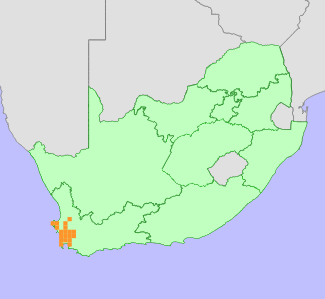|
Scientific Name | Antimima aristulata (Sond.) Chess. & Gideon F.Sm. |
Higher Classification | Dicotyledons |
Family | AIZOACEAE |
Synonyms | Antimima concinna (L.Bolus) H.E.K.Hartmann, Antimima menniei (L.Bolus) H.E.K.Hartmann, Mesembryanthemum aristulatum Sond., Mesembryanthemum comptum N.E.Br., Ruschia aristulata (Sond.) Schwantes, Ruschia concinna L.Bolus, Ruschia menniei L.Bolus, Ruschia pulchella (Haw.) Schwantes var. caespitosa L.Bolus |
National Status |
Status and Criteria | Endangered B2ab(ii,iii,iv,v) |
Assessment Date | 2022/11/11 |
Assessor(s) | P.F. Matlamela, D.A. Kamundi, C. Klak & N.A. Helme |
Justification | This species has a restricted area of occupancy (AOO) of 404 km², and the population has been severely fragmented due to 80% habitat loss to crop cultivation and urban development. Most subpopulations are small, consisting of fewer than 200 plants. The largest subpopulation in the Riverlands has several hundred plants, but less than 1000 mature individuals. Monitoring indicates that there is continuing decline due to ongoing habitat loss and degradation. It is therefore listed as Endangered under criterion B. |
Distribution |
Endemism | South African endemic |
Provincial distribution | Western Cape |
Range | It is endemic to the Western Cape Province, South Africa, where is occurs from Montagu to the Cape Peninsula and Vredenburg. |
Habitat and Ecology |
Major system | Terrestrial |
Major habitats | Saldanha Granite Strandveld, Swartland Shale Renosterveld, Peninsula Shale Renosterveld, Swartland Granite Renosterveld, Swartland Silcrete Renosterveld, Peninsula Granite Fynbos, Boland Granite Fynbos, Cape Flats Sand Fynbos, Atlantis Sand Fynbos, Leipoldtville Sand Fynbos, Swartland Alluvium Fynbos |
Description | Plants grow in shallow shale or granite soils. |
Threats |
| About 80% of this species' habitat has been severely reduced over the past 100 years. This was due to agriculture (wheat cultivation and vines) and urban development. This formerly common species is now reduced to small subpopulations restricted to small remnants of natural vegetation which is continually degraded by spreading unmanaged invasive plants, pollution (particularly from pesticides and herbicides), abandonment of land, harvesting for medicinal purposes, and inappropriate fire management. |
Population |
It was formerly common in the Western Cape, but the population has been much reduced and fragmented due to historical habitat loss to wheat cultivation and urban development. It now persists in fynbos and renosterveld fragments between crop fields, and most subpopulations are small, consisting of a few hundred plants. The largest subpopulation occurs in Riverlands Nature Reserve, where there are several hundred plants, but less than a thousand plants. It is estimated that there are around 1000-5000 plants.
|
Population trend | Decreasing |
Assessment History |
Taxon assessed |
Status and Criteria |
Citation/Red List version | | Antimima concinna (L.Bolus) H.E.K.Hartmann | Data Deficient (Taxonomically Problematic) | Raimondo et al. (2009) | | Antimima aristulata (Sond.) Chess. & Gideon F.Sm. | VU B1ab(ii,iii,iv,v) | Raimondo et al. (2009) | | Antimima menniei (L.Bolus) H.E.K.Hartmann | Least Concern | Raimondo et al. (2009) | |
Bibliography |
Chesselet, P., F., G. and Smith, G.F. 2001. Antimima aristulata comb. nov. (Mesembryanthemaceae Fenzl): a heterophyllous succulent from Cape Town, South Africa. Bradleya 19:121-123.
Goldblatt, P. and Manning, J.C. 2000. Cape Plants: A conspectus of the Cape Flora of South Africa. Strelitzia 9. National Botanical Institute, Cape Town.
Klak, C. 2000. Taxonomic studies in the Aizoaceae from South Africa: three new species and some new combinations. Bothalia 30(1):35-42.
Raimondo, D., von Staden, L., Foden, W., Victor, J.E., Helme, N.A., Turner, R.C., Kamundi, D.A. and Manyama, P.A. 2009. Red List of South African Plants. Strelitzia 25. South African National Biodiversity Institute, Pretoria.
|
Citation |
| Matlamela, P.F., Kamundi, D.A., Klak, C. & Helme, N.A. 2022. Antimima aristulata (Sond.) Chess. & Gideon F.Sm. National Assessment: Red List of South African Plants version 2024.1. Accessed on 2025/12/14 |
 Comment on this assessment
Comment on this assessment


